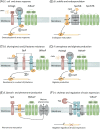The role of site-2-proteases in bacteria: a review on physiology, virulence, and therapeutic potential
- PMID: 37223736
- PMCID: PMC10202637
- DOI: 10.1093/femsml/uqad025
The role of site-2-proteases in bacteria: a review on physiology, virulence, and therapeutic potential
Abstract
Site-2-proteases are a class of intramembrane proteases involved in regulated intramembrane proteolysis. Regulated intramembrane proteolysis is a highly conserved signaling mechanism that commonly involves sequential digestion of an anti-sigma factor by a site-1- and site-2-protease in response to external stimuli, resulting in an adaptive transcriptional response. Variation of this signaling cascade continues to emerge as the role of site-2-proteases in bacteria continues to be explored. Site-2-proteases are highly conserved among bacteria and play a key role in multiple processes, including iron uptake, stress response, and pheromone production. Additionally, an increasing number of site-2-proteases have been found to play a pivotal role in the virulence properties of multiple human pathogens, such as alginate production in Pseudomonas aeruginosa, toxin production in Vibrio cholerae, resistance to lysozyme in enterococci and antimicrobials in several Bacillus spp, and cell-envelope lipid composition in Mycobacterium tuberculosis. The prominent role of site-2-proteases in bacterial pathogenicity highlights the potential of site-2-proteases as novel targets for therapeutic intervention. In this review, we summarize the role of site-2-proteases in bacterial physiology and virulence, as well as evaluate the therapeutic potential of site-2-proteases.
© The Author(s) 2023. Published by Oxford University Press on behalf of FEMS.
Conflict of interest statement
None declared.
Figures


Similar articles
-
Activation of the Extracytoplasmic Function σ Factor σV in Clostridioides difficile Requires Regulated Intramembrane Proteolysis of the Anti-σ Factor RsiV.mSphere. 2022 Apr 27;7(2):e0009222. doi: 10.1128/msphere.00092-22. Epub 2022 Mar 23. mSphere. 2022. PMID: 35317618 Free PMC article.
-
Pseudomonas aeruginosa Regulated Intramembrane Proteolysis: Protease MucP Can Overcome Mutations in the AlgO Periplasmic Protease To Restore Alginate Production in Nonmucoid Revertants.J Bacteriol. 2018 Jul 25;200(16):e00215-18. doi: 10.1128/JB.00215-18. Print 2018 Aug 15. J Bacteriol. 2018. PMID: 29784885 Free PMC article.
-
Function of site-2 proteases in bacteria and bacterial pathogens.Biochim Biophys Acta. 2013 Dec;1828(12):2808-14. doi: 10.1016/j.bbamem.2013.04.019. Biochim Biophys Acta. 2013. PMID: 24099002 Free PMC article. Review.
-
Regulated proteolysis: control of the Escherichia coli σ(E)-dependent cell envelope stress response.Subcell Biochem. 2013;66:129-60. doi: 10.1007/978-94-007-5940-4_6. Subcell Biochem. 2013. PMID: 23479440 Review.
-
Molecular Basis of the Versatile Regulatory Mechanism of HtrA-Type Protease AlgW from Pseudomonas aeruginosa.mBio. 2021 Feb 23;12(1):e03299-20. doi: 10.1128/mBio.03299-20. mBio. 2021. PMID: 33622718 Free PMC article.
Cited by
-
The Impact of Enterococcus spp. in the Immunocompromised Host: A Comprehensive Review.Pathogens. 2024 May 15;13(5):409. doi: 10.3390/pathogens13050409. Pathogens. 2024. PMID: 38787261 Free PMC article. Review.
-
Revisiting the Multifaceted Roles of Bacteriocins : The Multifaceted Roles of Bacteriocins.Microb Ecol. 2024 Feb 14;87(1):41. doi: 10.1007/s00248-024-02357-4. Microb Ecol. 2024. PMID: 38351266 Free PMC article. Review.
-
Structural basis for regulation of a CBASS-CRISPR-Cas defense island by a transmembrane anti-σ factor and its ECF σ partner.Sci Adv. 2024 Oct 25;10(43):eadp1053. doi: 10.1126/sciadv.adp1053. Epub 2024 Oct 25. Sci Adv. 2024. PMID: 39454004 Free PMC article.
-
Cryo-EM structure of the bacterial intramembrane metalloprotease RseP in the substrate-bound state.Sci Adv. 2025 Feb 28;11(9):eadu0925. doi: 10.1126/sciadv.adu0925. Epub 2025 Feb 26. Sci Adv. 2025. PMID: 40009668 Free PMC article.
-
Substrate engagement by the intramembrane metalloprotease SpoIVFB.Nat Commun. 2024 Oct 17;15(1):8276. doi: 10.1038/s41467-024-52634-6. Nat Commun. 2024. PMID: 39419996 Free PMC article.
References
-
- Akiyama Y, Kanehara K, Ito K. RseP (YaeL), an Escherichia coli RIP protease, cleaves transmembrane sequences. EMBO J. 2004;23:4434–42. https://doi.org/doi: 10.1038/sj.emboj.7600449. - DOI - PMC - PubMed
Publication types
LinkOut - more resources
Full Text Sources
Miscellaneous
